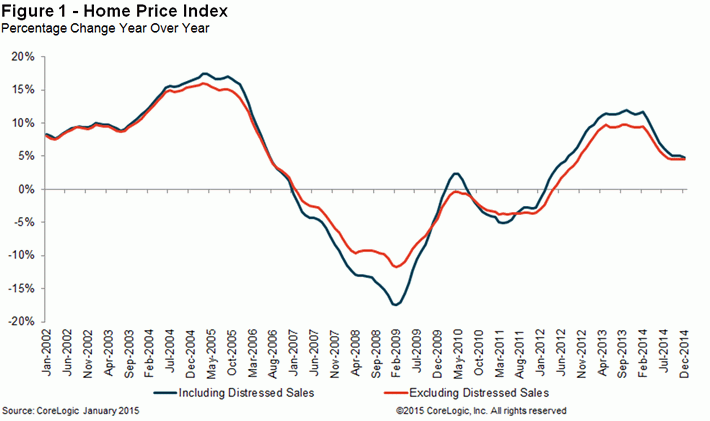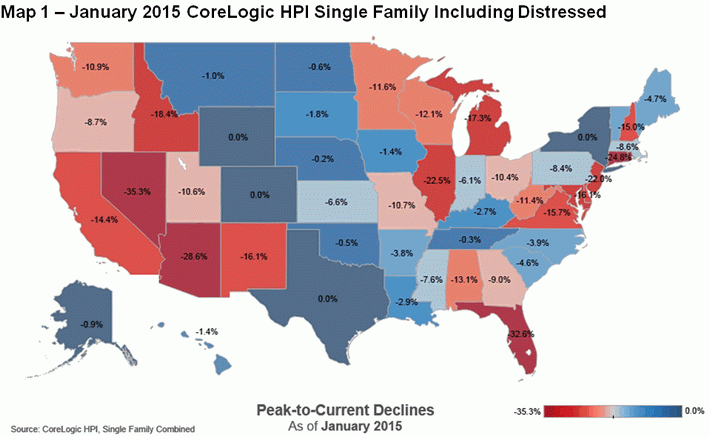Home prices, including sales of distressed properties, continued to appreciate on both an annual and a monthly basis in January. CoreLogic said that its Home Price Index including sales of foreclosed property and short sales, increased 5.7 percent in January compared to one year earlier. On a monthly basis the increase was 1.1 percent.

Including distressed sales, only Maryland and Connecticut showed negative home price appreciation at -0.3 percent and -1.9 percent respectively. The five states with the highest home price appreciation were Colorado (9.1 percent), Michigan (9.0 percent), Texas and Wyoming (8.3 percent each), and Nevada (7.6 percent.)
January was the 35th consecutive month that the index has increased on a year-over-year basis and nationally prices are now 12.7 percent below the pre-recession peak reached in April 2006. Four states established new index high points in January, New York, Wyoming, Texas, and Colorado. Including distressed sales, 27 states and the District of Columbia are at or within 10 percent of their peak but five states remain 25 percent or more off of those peaks. Nevada has the largest deficit at -35.3 percent followed by Florida, Rhode Island, Arizona, and Connecticut.

Excluding distressed sales the HPI was up 5.6 percent year-over-year and 1.4 percent for the month. Every state and the District of Columbia posted an annual gain and nationally prices have returned to within 8.6 percent of the HPI peak. The five states with the greatest annual price appreciation excluding distressed sales were Colorado (8.1 percent), Nevada (7.9 percent), Texas (7.8 percent), Massachusetts (7.7 percent), and Oregon (7.4 percent).
CoreLogic forecasts that home prices including distressed sales will increase 0.4 percent from January to February 2015 and 5.3 percent from January 2015 to January 2016. The HPI excluding distressed sales is projected to increase 0.3 percent and 4.9 percent for the two periods.
"House price appreciation has generally been stronger in the western half of the nation and weakest in the mid-Atlantic and northeast states," said Dr. Frank Nothaft, chief economist at CoreLogic. "In part, these trends reflect the strength of regional economies. Colorado and Texas have had stronger job creation and have seen 8 to 9 percent price gains over the past 12 months in our combined indexes. In contrast, values were flat or down in Connecticut, Delaware and Maryland in our overall index, including distressed sales."
Anand Nallathambi, president and CEO of CoreLogic said, "We continue to see a strong and progressive uptick in home prices as we enter 2015. We project home prices will continue to rise throughout the year and into 2016. A dearth of supply in many parts of the country is a big factor driving up prices. Many homeowners have taken advantage of low rates to refinance their homes, and until we see sustained increases in income levels and employment they could be hunkered down so supplies may remain tight. Demand has picked up as low mortgage rates and the cut in the FHA annual insurance premium reduce monthly payments for prospective homebuyers."
Ninety-four of the top 100 Core Based Statistical Areas (CBSAs) measured by population showed year-over-year increases in January 2015. The six that declined were New Orleans, Bridgeport-Stamford-Norwalk; Rochester, Baltimore, Wilmington, Delaware; and Hartford.







